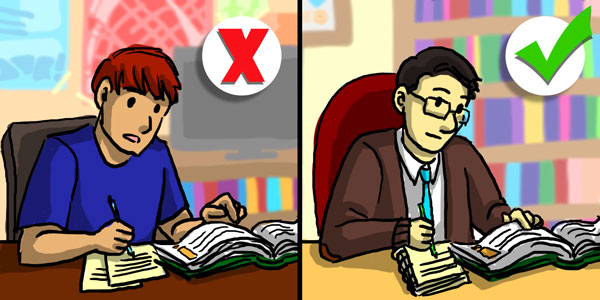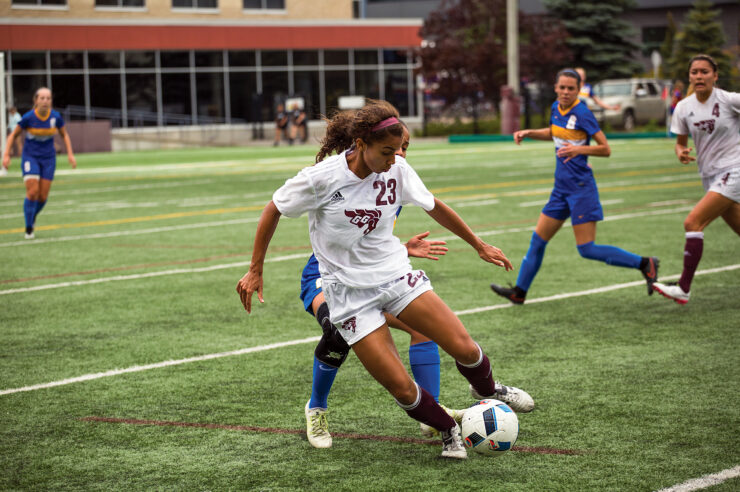When it comes to academic fraud, are students and professors being treated equally?
By this point in the year, the evils of academic fraud have probably been drilled into the brains of most new university students, as is the custom for professors and school administrators during the fall semester.
And why shouldn’t this be the case?
Thanks largely to the speed and accessibility of the Internet, it’s easier than ever to pass off someone else’s written work as your own. This phenomenon hits a lot closer to home than some would like to admit, since cases of academic fraud at the University of Ottawa rose by 48 per cent between 2008 and 2013.
Still, some believe this is just the tip of the iceberg.
“There’s a huge gap between what students are telling us they’re doing and the numbers of students that are being caught and sanctioned for those behaviours,” said Julia Christensen Hughes, the dean of the College of Management and Economics at the University of Guelph, in an article for CBC news.
But if we accept the very believable premise that students constantly get away with academic fraud, what does that mean for professors?
Despite being positioned as paragons of academic integrity, several high-profile cases of professors carrying out questionable behaviour have been popping up in recent years.
From bouts of self-plagiarism at the University of Toronto, to simple copy-paste jobs at Waterloo, to profs allegedly stealing their students’ work at the University of Regina, this veneer of moral superiority is starting to crack.
While it may seem like these examples are a rarity, one still has to wonder—does this happen on a much larger scale and, if so, are students being disproportionately punished for the exact same actions?
Through the academic looking glass
Luckily, these kinds of questions have not been lost on some members of the professoriate.
Dr. Benson Honig, a business professor from McMaster University, stumbled upon some surprising revelations regarding this topic when he attended the Academy of Management’s annual gathering of professional scholars in 2009.
“I was having lunch with (some) senior academics and I just sort of asked everyone what their gut feeling was. What percentage of the top publications had, let’s say, questionable errors in them?” recalls Honig, being concerned about the presence of dropped outliers and other manipulated data in published academic papers.
“Around the table the ranges were from a low of 30 per cent to a high of 80 per cent.”
While these statistics were purely anecdotal in nature, they were striking enough to encourage Honig to take a closer look at his colleagues’ works.
After examining 279 scholarly papers that were presented at this 2009 conference, Honig—and his research partner Akanksha Bedi—concluded that 25 per cent of these documents contained some degree of plagiarism.
While this number is below what was predicted by Honig’s lunch mates, the results are still pretty significant, especially considering the ease with which these two researchers went about unearthing this data.
“I used plagiarism (as a variable) because that was the easiest, most feasible thing to check,” said Honig, recounting how they got their results through the help of Turnitin, an online plagiarism detection service. “I would have loved to have checked a thousand other things, but that requires a lot of work.”
So, if this kind of academic fraud is so prevalent and so easily detectable, then why is the amount of regulations surrounding plagiarism at the faculty level so lacking in comparison to the evaluations done at the student level?
According to Mireille Gervais, the acting director of the Student Federation of the University of Ottawa’s Student Rights Centre (SRC), part of this imbalance comes down to the fact that many professors are not inundated with ethical guidelines or blunt “Beware of Plagiarism” manuals that specifically forbid this kind of behaviour.
“The rules binding professors are in no way as clear as the regulations applying to students on academic fraud,” said Gervais, referring to documents like the Association of Professors of the University of Ottawa’s Collective Agreement.
“There’s questions of giving due credit to your grad students in collective agreements, but a straight up policy that says ‘professors are not to plagiarize’, it does not exist at the U of O.”
Of course, someone in a position of authority could theoretically use these vague disciplinary guidelines to hand out deserving sanctions and reprimands when it comes to academic fraud. However, this is a lot easier said than done.
Behind closed doors
First of all, the answer to who is supposed to take responsibility for penalizing this kind of academic fraud remains a little unclear.
Honig states that the issue of accountability becomes muddled when you consider the fact that many of these plagiarized works are published in academic journals, publications that sometimes operate outside of a university administration’s jurisdiction.
“Most (universities) don’t have the time or the energy or the capability to go through and check these claims. The journals have an interest (in checking) because they have copyright,” he said. “It’s a very important question: who should be responsible to ensure the ethics of the professoriate? But the answer is not as clear.”
But to Gervais and her colleagues at the SRC, this issue is a lot more black and white.
“In our view it’s entirely the university’s job… because professors are employees of the deans. It would definitely fall within the deans’ powers to discipline those professors for wrongdoing.”
However, even in this context, Timothy Mott, a student rights’ advocate at the SRC, believes there’s still no guarantee that blatant academic malpractice will be met with an appropriate reaction.
“The university’s response will be, ‘well, we do have a process, we have a system in place for that and we’ll take care of it internally’,” said Mott. “But you can tell that whatever their system is, it’s nowhere near as harsh for them as it is for students.”
Throughout his years Mott has observed this process in action many times.
One of these stories involves a U of O business professor who handed out homework assignments that were rife with non-sourced content taken straight from Wikipedia and other online blogs. In addition to this, the professor also decided to tweak the data from its original source, according to Mott.
“It isn’t egregious, but it’s the kind of thing, nevertheless, that if you were a student and the committee saw that, they’d say you’re misrepresenting the source, you’re inventing data, you’re stealing it, and manipulating it at the same time,” said Mott. The professor wasn’t punished.
This double standard can even affect grad students, said Gervais. She even recalls one instance where a professor copy-pasted the work of a PhD candidate (of which he was the co-author) and republished it without that student’s permission.
The Fulcrum sought out an interview with this individual, but our request was denied after it was revealed that the student had signed a contract with the U of O agreeing not to speak about his case in exchange for a settlement.
“The unfortunate thing is that we don’t have any hard numbers to be able to provide,” said Bilan Arte, the national chairperson for the Canadian Federation of Students. “But I think that through the anecdotal experiences of students not only at the University of Ottawa but across the country, it’s pretty clear and evident that there is a problem here around these double standards.”
Cut from the same stolen cloth
Besides lax rules and a protective, collegial atmosphere, the underlying driving force that encourages many professors to copy-and-paste their problems away is not much different from that of students.
Although Mott admits that plenty of undergrads decide to cheat because they are either lazy or apathetic, he also believes that many of them simply “get stressed out and make questionable decisions.”
In Honig’s view, the same is true for professors, except the pressure to succeed is much more dire.
“The incentives are much greater for professors. These are very juicy jobs,” he said, referring to the career nirvana known as tenure, where a prof can hold onto their positions permanently without fear of contract re-negotiations. “Once you have tenure it’s almost impossible to fire you.”
However, before you break out the sarcastic violins for these “poor” profs and their alleged six figure salaries, it must be noted that the path to tenure-track heaven is not what it used to be.
While Canadian academics are often cited as being the best paid in the world for their respective profession, that mostly applies to those who have been around for a while. These days it’s a whole different story.
“They’re great jobs, but they’re very competitive, not everyone can get them, and the people that do… they’re really fighting now,” said Honig, alluding to the fact that most Canadian university students today are taught by part-time professors, who are forced to work longer hours, for less pay, without much job security.
This situation is exacerbated by the fact that, in this current system, one of the only sure fire ways to move up in the ranks is to write a book or to get your research published—which is hard to do when you spend 60-70 hours a week grading papers for a salary that barely raises some above the poverty line ($6,500-8,500 per course at the U of O) .
To make matters worse, Honig explains that “there are fewer and fewer journal place openings for articles, the standards are getting higher and higher all the time, so it’s like a war out there.”
This sad reality doesn’t excuse professors who give into the temptation to take a short cut with their research. However, it definitely explains the sheer amount of plagiarism outlined in Honig’s study and the reluctance for university to crack down on this practice in the first place.
Stomping out plagiarism in all its forms
Of course, none of this is to suggest that we should be more lenient on those who are caught committing academic fraud.
Despite what some cynics say, university degrees should mean something, and there’s no quicker way of cheapening someone’s diploma then by allowing such academic dishonesty to persist.
The best way to stop this from happening is by stomping out plagiarism in all its forms.
For Honig, this means tightening up some of the vague and wishy-washy ethical codes that allow many professors to escape punishment when they perpetuate academic fraud.
“In some professions… like law and medicine, they have a code of ethics that you have to adhere to, and once you fail you can’t be a practicing lawyer or doctor if you’ve been kicked out of the profession,” he said. “I would advocate that for the professoriate.”
For student advocates like Arte, the best remedy for this current predicament is simply more transparency and accountability on part of the university administrations.
“These institutions should probably be looking inwards a little bit, particularly after seeing the rates of plagiarism go up,” she said.
Hopefully in the future more studies in the same vein of Honig’s research can see the light of day, so that this double standard in academic fraud can be a thing of the past.
Until then, Honig encourages students from across the country to remain wary about what goes on behind closed doors at their university administration building.
“I think you have every right as a student to ask, ‘why aren’t professors held to at least the same standard that we students are?’”
(This article is an expansion of an op-ed written by Justin Dallaire. You can read that original article here)





